Chitin utilization by the insect-transmitted bacterium Xylella fastidiosa
- PMID: 20656858
- PMCID: PMC2937478
- DOI: 10.1128/AEM.01036-10
Chitin utilization by the insect-transmitted bacterium Xylella fastidiosa
Abstract
Xylella fastidiosa is an insect-borne bacterium that colonizes xylem vessels of a large number of host plants, including several crops of economic importance. Chitin is a polysaccharide present in the cuticle of leafhopper vectors of X. fastidiosa and may serve as a carbon source for this bacterium. Biological assays showed that X. fastidiosa reached larger populations in the presence of chitin. Additionally, chitin induced phenotypic changes in this bacterium, notably increasing adhesiveness. Quantitative PCR assays indicated transcriptional changes in the presence of chitin, and an enzymatic assay demonstrated chitinolytic activity by X. fastidiosa. An ortholog of the chitinase A gene (chiA) was identified in the X. fastidiosa genome. The in silico analysis revealed that the open reading frame of chiA encodes a protein of 351 amino acids with an estimated molecular mass of 40 kDa. chiA is in a locus that consists of genes implicated in polysaccharide degradation. Moreover, this locus was also found in the genomes of closely related bacteria in the genus Xanthomonas, which are plant but not insect associated. X. fastidiosa degraded chitin when grown on a solid chitin-yeast extract-agar medium and grew in liquid medium with chitin as the sole carbon source; ChiA was also determined to be secreted. The gene encoding ChiA was cloned into Escherichia coli, and endochitinase activity was detected in the transformant, showing that the gene is functional and involved in chitin degradation. The results suggest that X. fastidiosa may use its vectors' foregut surface as a carbon source. In addition, chitin may trigger X. fastidiosa's gene regulation and biofilm formation within vectors. Further work is necessary to characterize the role of chitin and its utilization in X. fastidiosa.
Figures




Similar articles
-
A chitinase is required for Xylella fastidiosa colonization of its insect and plant hosts.Microbiology (Reading). 2017 Apr;163(4):502-509. doi: 10.1099/mic.0.000438. Epub 2017 Apr 22. Microbiology (Reading). 2017. PMID: 28141489
-
Natural Competence of Xylella fastidiosa Occurs at a High Frequency Inside Microfluidic Chambers Mimicking the Bacterium's Natural Habitats.Appl Environ Microbiol. 2016 Aug 15;82(17):5269-77. doi: 10.1128/AEM.01412-16. Print 2016 Sep 1. Appl Environ Microbiol. 2016. PMID: 27316962 Free PMC article.
-
Csp1, a Cold Shock Protein Homolog in Xylella fastidiosa Influences Cell Attachment, Pili Formation, and Gene Expression.Microbiol Spectr. 2021 Dec 22;9(3):e0159121. doi: 10.1128/Spectrum.01591-21. Epub 2021 Nov 17. Microbiol Spectr. 2021. PMID: 34787465 Free PMC article.
-
Xylella fastidiosa's relationships: the bacterium, the host plants, and the plant microbiome.New Phytol. 2022 Jun;234(5):1598-1605. doi: 10.1111/nph.18089. Epub 2022 Apr 5. New Phytol. 2022. PMID: 35279849 Review.
-
Microbe Profile: Xylella fastidiosa - a devastating agricultural pathogen with an endophytic lifestyle.Microbiology (Reading). 2021 Oct;167(10):001091. doi: 10.1099/mic.0.001091. Microbiology (Reading). 2021. PMID: 34596503 Free PMC article. Review.
Cited by
-
Intestinal probiotics restore the ecological fitness decline of Bactrocera dorsalis by irradiation.Evol Appl. 2018 Oct 9;11(10):1946-1963. doi: 10.1111/eva.12698. eCollection 2018 Dec. Evol Appl. 2018. PMID: 30459840 Free PMC article.
-
Effects of contaminants of emerging concern on Megaselia scalaris (Lowe, Diptera: Phoridae) and its microbial community.Sci Rep. 2017 Aug 15;7(1):8165. doi: 10.1038/s41598-017-08683-7. Sci Rep. 2017. PMID: 28811598 Free PMC article.
-
A Single Host-Derived Glycan Impacts Key Regulatory Nodes of Symbiont Metabolism in a Coevolved Mutualism.mBio. 2015 Jul 14;6(4):e00811. doi: 10.1128/mBio.00811-15. mBio. 2015. PMID: 26173698 Free PMC article.
-
An N-acetylglucosamine transporter required for arbuscular mycorrhizal symbioses in rice and maize.Nat Plants. 2017 May 26;3:17073. doi: 10.1038/nplants.2017.73. Nat Plants. 2017. PMID: 28548655 Free PMC article.
-
Asian Citrus Psyllid Expression Profiles Suggest Candidatus Liberibacter Asiaticus-Mediated Alteration of Adult Nutrition and Metabolism, and of Nymphal Development and Immunity.PLoS One. 2015 Jun 19;10(6):e0130328. doi: 10.1371/journal.pone.0130328. eCollection 2015. PLoS One. 2015. PMID: 26091106 Free PMC article.
References
-
- Almeida, R. P. P., M. J. Blua, J. R. S. Lopes, and A. H. Purcell. 2005. Vector transmission of Xylella fastidiosa: applying fundamental knowledge to generate disease management strategies. Ann. Entomol. Soc. Am. 98:775-786.
-
- Almeida, R. P. P., and A. H. Purcell. 2006. Patterns of Xylella fastidiosa colonization on the precibarium of sharpshooter vectors relative to transmission to plants. Ann. Entomol. Soc. Am. 99:884-890.
-
- Anderson, S. O. 1979. Biochemistry of insect cuticle. Annu. Rev. Entomol. 24:29-59.
-
- Bradford, M. M. 1976. A rapid and sensitive method for the quantification of microgram quantities of protein utilizing the principle of protein-dye binding. Anal. Biochem. 72:248-254. - PubMed
-
- Broekaert, W. F., J. V. Parijs, A. K. Allen, and W. J. Peumans. 1988. Comparison of some molecular, enzymatic and antifungal properties of chitinase from thorn-apple, tobacco and wheat. Physiol. Mol. Plant Pathol. 33:319-331.
Publication types
MeSH terms
Substances
LinkOut - more resources
Full Text Sources
Molecular Biology Databases

